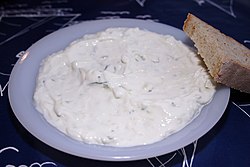
Esta ensalada es de mis preferidas y extremadamente fácil de hacer:
1/2 pepino
1 - 2 dientes de ajo muy picaditos
2 yogures griegos
Aceite de oliva
Menta picada, eneldo, sal y pimienta
Pela el pepino y córtalo en trozos, échale un poco de sal por encima y deja que repose mientras preparas el resto de ingredientes.Cuando hayan pasado unos minutos se seca el pepino con un papel de cocina e intenta exprimir la mayor cantidad de agua posible. Se coloca en un bol con el ajo picado, y el yogur, sal y especias al gusto, dale un par de vueltas para que se mezcle. Añade un chorro de aceite de oliva y si te gusta bien fresco un chorro de zumo de limón. Puede añadirse también patata cocida, frutos secos (piñones… etc)
Es mejor hacerla un rato antes de servir y dejarla reposar en la nevera, los sabores se intensifican.
=============================
 | |
| Origin | |
|---|---|
| Place of origin | Greece |
| Details | |
| Course | Appetizer |
| Type | Dip |
| Mainingredient(s) | Strained yogurt, cucumbers, garlic,olive oil, salt and sometimes lemon juice, dill or mint or parsley |
Tzatziki (Anglicised: pron.: /zɑːdˈziːki/; Greek: τζατζίκι [dzaˈdzici] or [dʒaˈdʒici]; Turkish: cacık[dʒaˈdʒɯk]; Albanian: xaxiq[citation needed] ; Persian: ماست و خیار) is a Greek appetizer, also used as a sauce for gyros. Tzatziki is made of strained yogurt (usually from sheep or goatmilk) mixed with cucumbers, garlic, salt, olive oil, and sometimes lemon juice, and dill or mintor parsley.[1] Tzatziki is always served cold. While in Greece and Turkey the dish is usually served as an accompaniment, in other places tzatziki is often served with bread (loaf or pita) as part of the first course of a meal.
| 1 Etymology |
[edit]Etymology
The name comes from the Turkish dish cacık, which contains many of the same ingredients but is considerably more liquid.
[edit]Variations
Turkish cacık, the more diluted cousin of tzatziki, is usually served as an accompaniment to meat, though it is suggested as a soup or a salad also.[2] Usual ingredients are yogurt (from goat's milk), cucumber, salt, garlic, and dried and crushed wild mint.[3] When served as a meze (appetizer), it is of a thicker consistency, indistinguishable from tzatziki.
In Cyprus, the dish is known as talattouri[4] (cf. tarator), and recipes often include less garlic and includes the herb mint, unlike the Greek counterpart.
In Bulgaria, Republic of Macedonia and Serbia, the same dish is known as "dry tarator" (Bulgarian:сух таратор, Macedonian: сув таратур, Serbian: сув таратор) "Snezhanka" salad (салата "Снежанка"), which means "snow white salad", and is served as an appetizer. During preparation, the yogurt (Bulgarian: кисело мляко, Macedonian: кисело млеко, Serbian: кисело млеко) is hung for several hours in a kerchief and loses about half of its water (drained yogurt, Bulgarian: цедено кисело мляко, Serbian: цеђено кисело млеко, Macedonian: цедено кисело млеко). The cucumbers, garlic, minced walnuts, salt and vegetable oil are then added.
Similar dishes in Iraq are known as jajeek, normally served as meze alongside alcoholic drinks, especially Arak, an Ouzo-like drink made from dates.
A variation in the Caucasus mountains, called ovdukh, uses kefir instead of the yogurt, thus creating a refreshing summer drink. This can be poured over a mixture of vegetables, eggs and ham to create a variation of okroshka, sometimes referred to as a 'Caucasus okroshka'.
A similar dish is made in Iran, called mast-o-khiar literally meaning yogurt with cucumber. It is made using a thicker yogurt, which is mixed with sliced cucumber, garlic, and dill (sometimes chopped nuts are also added as a garnish). Iranians take the dish a step further, substituting shallots, called mast-o-moussir.
Cacık may also be compared with raita and pachadi in India, all are served as a refreshing appetizer along with other dishes.
[edit]Recipe
Ingredients (for 6 portions):[5]
- 2 trays of strained yoghurt ( 200 gr. each )
- 4 garlic cloves
- a pinch of salt
- 2 spoonfuls of vinegar
- 5 spoonfuls of olive oil
- 1 medium-sized cucumber
Preparation:
Wash the cucumber, cut off the edges and grate it. Squeeze it and drain it well to eliminate excess water.
Peel the garlic cloves and grate them.
In a bowl, mix together all the ingredients and stir them well.
Put the bowl in the fridge. When the tzatziki cools, it is ready to be served.
Wash the cucumber, cut off the edges and grate it. Squeeze it and drain it well to eliminate excess water.
Peel the garlic cloves and grate them.
In a bowl, mix together all the ingredients and stir them well.
Put the bowl in the fridge. When the tzatziki cools, it is ready to be served.
Preparation time: approx. 5 min.

No comments:
Post a Comment